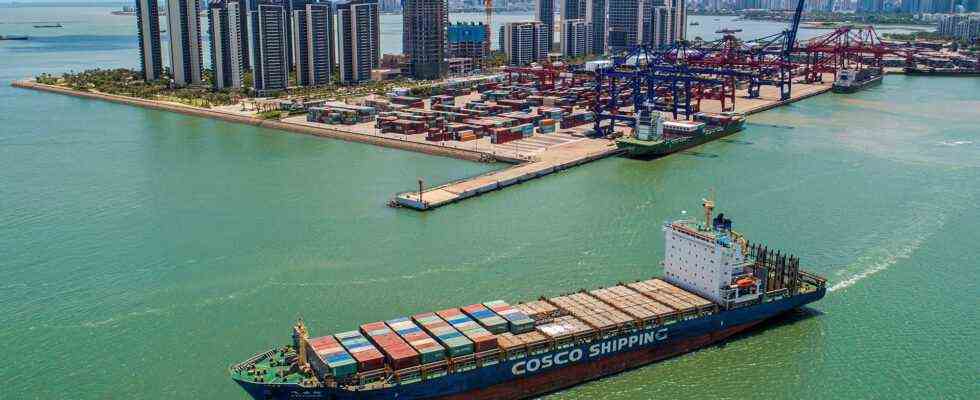Status: 07/16/2021 12:21 p.m.
Container ships are jammed in front of the ports, the prices for freight containers are exploding, and there are problems in the supply chains around the world. The reasons and consequences of the container crisis are diverse. Impressions from different trading regions of the world.
The situation in China
From Steffen Wurzel,
ARD studio Shanghai
The Futian container terminal near the southern Chinese metropolis of Shenzhen is one of the largest cargo ports in the world. If it comes to a standstill there, the entire world trade suffers. This is what happened around two months ago: Due to a few cases of corona infection, numerous dock workers had to stay at home. For weeks, only less than half as many freight containers could be handled in Futian as usual.
The result was a traffic jam for dozens of giant container ships off the southern Chinese coast. Important components, machines and raw materials could not be delivered to China. Conversely, export products could not get out of China: computers, smartphones, bicycles and coffee machines, for example. In the meantime, operations in Shenzhen / Futian are up and running again. But there is still a backlog.
Regardless of the corona-related port closure in southern China, there is an unprecedented shortage of containers in the People’s Republic. Freight prices have increased roughly tenfold. German medium-sized companies sometimes speak of “existential problems”.
In some cases, shipping goods in containers to Europe now costs more than the freight that is in the container. Sending goods to China has also become incredibly expensive. There is no improvement in sight, at least in the short term, on the contrary. A German business representative said that ARD radio studio Shanghai: The container crisis will probably continue into next year.
Due to corona cases, container handling in the port near the Chinese metropolis of Shenzhen stalled for weeks – the result was a jam of container ships
Image: REUTERS
The situation in the USA
From Nils Dampz,
ARD studio Los Angeles
Container jams in Los Angeles: Cargo ships still have to anchor in front of the port for days before they can be loaded and unloaded. Because the Americans are so eager to order. Above all, clothing, electronics, Halloween items, household appliances and furniture are transported to Los Angeles. Goods that leave the country are only found in every fifth container.
The port in Los Angeles reports record numbers. Never before have so many containers been handled in a June, never before have more than a million been handled in a month, as in May. But the many containers cause traffic jams. Ships currently have to wait around five days in front of the port before they can unload their cargo. There are also not enough trucks to quickly transport the containers further into the country.
Because containers are scarce worldwide, transport costs have exploded. Many goods for the USA come from Asia. The price for a container on the route is now more than three times as high as it was in early 2020. This is particularly problematic for small and medium-sized traders. You pay significantly more for the transport and have to wait even longer for your goods.
Container ships currently have to wait an average of five days before they can enter the largest port in the USA for unloading.
Image: REUTERS
The location on the Suez Canal
By Jürgen Stryjak, ARD-Studio Cairo,
currently Berlin
Almost four months ago the container ship “Ever Given” ran aground in the Suez Canal and blocked the waterway for six days – which seriously disrupted world trade. Because 15 percent of its volume is shipped through the Suez Canal.
The backlog of around 400 ships cleared within a few days. There are no more delays. In the meantime, the “Ever Given” with more than 18,000 containers has been able to leave Egypt again after the Japanese owner and the Suez Canal authorities reached an agreement on the amount of compensation.
None of this seems to have harmed the authority. Despite the accident, it recorded record income. In the first half of 2021, it earned three billion US dollars in transit fees, 240 million more than in the same period in 2020. To keep it that way, the canal will be expanded. The section in which the “Ever Given” got wedged is widened by 40 meters and deepened by almost two meters.
The blockade of the Suez Canal by the “Ever Given” showed how vulnerable world trade is to disruptions on the central trade routes.
Image: AFP
The situation in Singapore
From Jennifer Lange,
ARD studio Singapore
The port of Singapore is recovering. In the first five months of this year, more freight was handled than in the same period of 2019 and 2020. However, port closings, delays of ships and congestion in the ports have not left Singapore without a trace.
The port is partially overloaded because cargo does not arrive on schedule, explains the port operator PSA. For the large container ships, the waiting time is just five to seven days. Otherwise there are two. In this context, the Singapore Minister of Transport quoted the saying last week: “The pessimist complains about the wind. The optimist expects it to turn. The realist hoists the sails.”
Singapore wants to solve the delays with innovation and digitization. With better tracking of the containers, for example, supply chains could be optimized in the event of problems. They helped seafarers with telemedicine and enabled well over 100,000 crew changes. At the moment, seafarers can also be vaccinated in the port.
According to the operator, the port of Singapore is currently partially overloaded. The problem of delays should be solved with innovation and digitization.
Image: AFP



